Soil Quality and Heavy Metal Source Analyses for Characteristic Agricultural Products in Luzuo Town, China
Abstract
1. Introduction
2. Materials and Methods
2.1. Study Area
2.2. Sample Collection and Pretreatment
2.3. Analyzing and Testing Methods
2.4. Geoaccumulation Index Method (Igeo)
2.5. Potential Ecological Risk Index (PERI) Method
2.6. Moran’s Index (I)
2.7. Positive Definite Matrix Factorization (PMF) Model
2.8. Data Processing
3. Results and Discussion
3.1. Characteristics of Soil Heavy Metal Element Content
3.2. Soil Heavy Metal Correlation
3.3. Characteristics of Spatial Distribution of Heavy Metals in Soil
3.4. Spatial Correlation Analysis
3.5. Spatial Cluster Analysis
3.6. Soil Heavy Metal Risk Evaluation
3.7. Heavy Metal Source Analysis
4. Conclusions
Supplementary Materials
Author Contributions
Funding
Data Availability Statement
Acknowledgments
Conflicts of Interest
References
- Hu, W.Y.; Wang, H.F.; Dong, L.R.; Huang, B.A.; Borggaard, O.K.; Hansen, H.C.B.; He, Y.; Holm, P.E. Source identification of heavy metals in peri-urban agricultural soils of southeast China: An integrated approach. Environ. Pollut. 2018, 237, 650–661. [Google Scholar] [CrossRef] [PubMed]
- Liu, G.N.; Wang, J.; Liu, X.; Liu, X.H.; Li, X.S.; Ren, Y.Q.; Wang, J.; Dong, L.M. Partitioning and geochemical fractions of heavy metals from geogenic and anthropogenic sources in various soil particle size fractions. Geoderma 2018, 312, 104–113. [Google Scholar] [CrossRef]
- Zhang, L.P.; Ye, X.; Feng, H.; Jing, Y.H.; Ouyang, T.; Yu, X.T.; Liang, R.Y.; Gao, C.T.; Chen, W.Q. Heavy metal contamination in western Xiamen Bay sediments and its vicinity, China. Mar. Pollut. Bull. 2007, 54, 974–982. [Google Scholar] [CrossRef] [PubMed]
- Frohne, T.; Rinklebe, J.; Diaz-Bone, R.A. Contamination of Floodplain Soils along theWupper River, Germany, with As, Co, Cu, Ni, Sb, and Zn and the Impact of Pre-definite Redox Variations on the Mobility of These Elements. Soil Sediment Contam. 2014, 23, 779–799. [Google Scholar] [CrossRef]
- Nachman, K.E.; Punshon, T.; Rardin, L.; Signes-Pastor, A.J.; Murray, C.J.; Jackson, B.P.; Guerinot, M.L.; Burke, T.A.; Chen, C.Y.; Ahsan, H.; et al. Opportunities and Challenges for Dietary Arsenic Intervention. Environ. Health Persp. 2018, 126, 8–084503. [Google Scholar] [CrossRef]
- Dai, X.Y.; Liang, J.H.; Shi, H.D.; Yan, T.Z.; He, Z.X.; Li, L.; Hu, H.L. Health risk assessment of heavy metals based on source analysis and Monte Carlo in the downstream basin of the Zishui. Environ. Res. 2024, 245, 117975. [Google Scholar] [CrossRef]
- Yang, L.X.; Meng, F.H.; Ma, C.; Hou, D.W. Elucidating the spatial determinants of heavy metals pollution in different agricultural soils using geographically weighted regression. Sci. Total Environ. 2022, 853, 158628. [Google Scholar] [CrossRef]
- Baktemur, G. The Effect of Some Heavy Metals on the Growth of Garlic under In Vitro Conditions. Hortscience 2022, 58, 1–5. [Google Scholar] [CrossRef]
- Soudek, P.; Petrová, S.; Vaněk, T. Heavy metal uptake and stress responses of hydroponically cultivated garlic (Allium sativum L.). Environ. Exp. Bot. 2011, 74, 289–295. [Google Scholar] [CrossRef]
- Dong, H.X. Effects of Lead and Cadmium Stress on Some Physiological and Biochemical Indicators of Garlic. J. Shangrao Norm. Univ. 2012, 32, 76–80. Available online: https://link.cnki.net/urlid/36.1241.C.20120913.1507.009 (accessed on 21 June 2025).
- Zhuang, Y.N. Current Status and Strategies for Enhancing Economic Benefits of the Garlic Industry in Linyi. Spec. Econ. Anim. Plants 2025, 28, 174–176. Available online: https://kns.cnki.net/kcms2/article/abstract?v=a4fp6zKrpgYswCb29ZQ2Km9g-t8CrDk5QGRUFSc8PKWen0578Erwpa5HqVWLIdmtH5A2ePf5SEAFE2JnJzRvni-p0a372QAay97Oooz-weSj5eQRAYGtJYMHOY8dv2z60PifYPmOPfGEekej_BsXilsmjKzoYvrnZ83k9nvurR09wFd41iNeZ-DW8gm6ZJ6a&uniplatform=NZKPT&language=CHS (accessed on 21 June 2025).
- Hu, Y.H.; Wang, H.X.; Wang, Z.K.; Wang, C.W.; Zhao, B.; Fu, Q.L.; Ning, F.Z.; Hu, J.C.; Shen, Q. Geochemical Characteristics and Environmental Quality Evaluation of Heavy Metal Elements in Soils of Qi County Garlic Planting Area. J. Anhui Agric. Sci. 2006, 1411–1412. Available online: https://link.cnki.net/doi/10.13989/j.cnki.0517-6611.2006.07.071 (accessed on 21 June 2025).
- Bo, L.J.; Li, B.; Zhang, R.Q.; Li, Y.P.; Li, Y.; Duan, G.; Gao, X.H. Characteristics of Heavy Metals in Soils of Garlic Planting Areas in Jinxian County and Assessment of Potential Ecological Risks. Chin. J. Soil Sci. 2021, 52, 434–442. Available online: https://link.cnki.net/doi/10.19336/j.cnki.trtb.2020061601 (accessed on 21 June 2025).
- Li, Y.C. Research on Countermeasures for Livestock Farming Pollution Prevention and Control in Lanling County. Shandong Agricultural University, Tai’an, China. 2022. Available online: https://link.cnki.net/doi/10.27277/d.cnki.gsdnu.2022.000788 (accessed on 21 June 2025).
- Zhang, R.; Tian, Y. Climate suitability analysis of garlic planting in Luling County and meteorological service suggestions. J. South. Agric. 2022, 16, 158–161. Available online: https://link.cnki.net/doi/10.19415/j.cnki.1673-890x.2022.07.038 (accessed on 21 June 2025).
- Shu, P. Quantitative Study of the Latest Late Cenozoic Right-Slip Movement in the Tanlu Fault Zone and Its Tectonic Significance—Based on Tectonic and Sedimentary Constraints in the Panquan Lafen Basin; Institute of Geology, China Earthquake Administration, Beijing, China. 2023. Available online: https://link.cnki.net/doi/10.27489/d.cnki.gzdds.2023.000003 (accessed on 21 June 2025).
- DZ/T 0295-2016; Specifications for Geochemical Assessment of Land Quality. China National Standardization Management Committee: Beijing, China, 2016. Available online: https://g.mnr.gov.cn/201701/t20170123_1430074.html (accessed on 21 June 2025).
- Muller, G. Index of Geoaccumulation in Sediments of the Rhine River. Geo J. 1969, 2, 109–118. [Google Scholar]
- Hakanson, L. An ecological risk index for aquatic pollution control. A sedimentological approach. Water Res. 1980, 14, 975–1001. [Google Scholar] [CrossRef]
- Huang, X.Y.; Wang, L.; Pan, H.; Xie, F.F. Trends and spatial effects of PM 2.5 and PM 10 in the Yangtze River Delta urban agglomeration. Environ. Poll. Control 2021, 43, 1309–1315. Available online: https://link.cnki.net/doi/10.15985/j.cnki.1001-3865.2021.10.016 (accessed on 21 June 2025).
- Paatero, P. Least squares formulation of robust non-negative factor analysis. Chemometr. Intell. Lab. 1997, 37, 23–35. [Google Scholar] [CrossRef]
- Wang, Y.M.; Zhang, L.X.; Wang, J.N.; Lv, J.S. Identifying quantitative sources and spatial distributions of potentially toxic elements in soils by using three receptor models and sequential indicator simulation. Chemosphere 2020, 242, 125266. [Google Scholar] [CrossRef]
- Paatero, P.; Tapper, U. Positive matrix factorization: A non-negative factor model with optimal utilization of error estimates of data values. Environmetrics 1994, 5, 111–126. [Google Scholar] [CrossRef]
- Pang, X.G.; Dai, J.R.; Chen, L.; Liu, D.F.; Yu, C.; Han, L.; Ren, T.L.; Hu, X.P.; Wang, H.J.; Wang, Z.H.; et al. Geochemical Background Values of Soils in 17 Cities of Shandong Province. Shandong Land Resour. 2019, 35, 46–56. Available online: https://kns.cnki.net/kcms2/article/abstract?v=AGqaFAGiW5_z3AO_R29qOu0miP1WqkkImgnz3VV_9p1GQ3zoz5pfhiO3ymo7nJdmk6qnvnEa6AyyCliyJMLzsh2xK1EUtxrSVR7MoMJ58qXyaLi5prsILCeKvHu3dd_2CS0NUzC_ruG7NeS8SoCP0RCTqlOwKMA91palTtqeiGHYp2lcJSHomiZbUMNmsOwwwQbNcgU79XE=&uniplatform=NZKPT&language=CHS (accessed on 21 June 2025).
- Yu, L.S.; Wan, F.; Fan, H.Y.; Kang, G.L.; Liu, H.; Wang, D.P.; Xu, J. Spatial Distribution, Source Apportionment and Ecological Risk Assessment of Heavy Metals in Soils of the Jianghu Gongmi Production Area. China Environ. Sci. 2022, 43, 4199–4211. Available online: https://link.cnki.net/doi/10.13227/j.hjkx.202112133 (accessed on 21 June 2025).
- GB 15618; Soil Environmental Quality: Risk Control Standard for Soil Contamination of Agricultural Land. Ministry of Ecology and Environment: Beijing, China, 2018. Available online: https://www.mee.gov.cn/ywgz/fgbz/bz/bzwb/trhj/201807/t20180703_446029.shtml (accessed on 21 June 2025).
- Hu, Z.X.; Wu, Z.Y.; Luo, W.Q.; Liu, S.H.; Tu, C. Spatial distribution, risk assessment, and source apportionment of soil heavy metals in a karst county based on grid survey. Sci. Total Environ. 2024, 953, 176049. [Google Scholar] [CrossRef] [PubMed]
- Tang, J.L.; Zhao, K.; Hu, Y.X.; Xu, T.; Wang, Y.X.; Yang, Y.; Zhou, B.H. Characterization, source analysis and pollution evaluation of heavy metals in surface soil of Chuzhou City. China Environ. Sci. 2023, 44, 3562–3572. Available online: https://link.cnki.net/doi/10.13227/j.hjkx.202208031 (accessed on 21 June 2025).
- Anaman, R.; Chi, P.; Jiang, Z.C.; Liu, X.; Zhou, Z.R.; Guo, Z.H.; Xiao, X.Y. Identifying sources and transport routes of heavy metals in soil with different land uses around a smelting site by GIS based PCA and PMF. Sci. Total Environ. 2022, 823, 153759. [Google Scholar] [CrossRef]
- Wilding, L.P. Spatial variability: Its documentation, accomodation and implication to soil surveys. Spat. Var. 1985, 166–187. [Google Scholar]
- Zhuang, S.L. Environmental Data Analysis; Science Press: Beijing, China, 2020; pp. 63–67. [Google Scholar]
- Wei, A.N.; Jia, J.; Chang, P.Y.; Wang, S.L. Probabilistic risk assessment and source identification of heavy metals in soil-rice systems in northern area of Fujian Province, China. Ecol. Indic. 2025, 174, 113504. [Google Scholar] [CrossRef]
- Huang, M.Q.; Cheng, J.W.; Zeng, B.P.; Cai, S.W. Morphological Enrichment and Environmental Factors Correlation of Heavy Metals in Dominant Plants in Typical Manganese Ore Areas in Guizhou, China. Environ. Manag. 2024, 74, 942–957. [Google Scholar] [CrossRef]
- Zhong, X.L.; Zhou, S.L.; Zhao, Q.G.; Li, J.T.; Liao, Q.L. Synergistic regionalization analysis, spatial correlation analysis and spatial principal component analysis of the effective state of heavy metals in soils of the Yangtze River Delta. China Environ. Sci. 2007, 2758–2765. Available online: https://link.cnki.net/doi/10.13227/j.hjkx.2007.12.011 (accessed on 21 June 2025).
- Li, Z.C.; Wang, Y.H.; Chen, S.; Ma, J.; Wang, G.X.; Xu, X.G.; Huang, H.Y.; Zhu, Y.K. Pollution assessment and source analysis of heavy metals in sediment of Lake Tuohu in Huaihe River Basin. J. Lake Sci. 2025, 37, 889–901. Available online: https://link.cnki.net/urlid/32.1331.P.20250114.1423.002 (accessed on 21 June 2025).
- Zhu, B.L.; Kun, L.; Zhou, J.; Li, L. Analysis of Heavy Metal Sources and Sustainability: Human Health Risk Assessment of Typical Agricultural Soils in Tianjin, North China Plain. Sustainability 2025, 17, 3738. [Google Scholar] [CrossRef]
- Laniyan, T.A.; Popoola, O.J. Integrated Assessment of Heavy Metal Contamination in Urban Road Dust: Implications for Human Health and Ecosystem Sustainability in Abeokuta, Nigeria. Environ. Forensics 2024, 26, 204–222. [Google Scholar] [CrossRef]
- Xia, Y.F.; Liu, Y.H.; Chen, T.; Xu, Y.D.; Qi, M.; Sun, G.Y.; Wu, X.; Chen, M.J.; Xu, W.P.; Liu, C.S. Combining Cd and Pb isotope analyses for heavy metal source apportionment in facility agricultural soils around typical urban and industrial areas. J. Hazard. Mater. 2024, 466, 133568. [Google Scholar] [CrossRef] [PubMed]
- Cheng, Z.; Chen, L.J.; Li, H.H.; Lin, J.Q.; Yang, Z.B.; Yang, Y.X.; Xu, X.X.; Xian, J.R.; Shao, J.R.; Zhu, X.M. Characteristics and health risk assessment of heavy metals exposure via household dust from urban area in Chengdu, China. Sci. Total Environ. 2018, 619, 621–629. [Google Scholar] [CrossRef]
- Zhang, Y.Q.; Jiang, B.; Gao, Z.J.; Wang, M.; Feng, J.G.; Xia, L.; Liu, J.T. Health risk assessment of soil heavy metals in a typical mining town in north China based on Monte Carlo simulation coupled with Positive matrix factorization model. Environ. Res. 2024, 251, 118696. [Google Scholar] [CrossRef] [PubMed]
- Wang, Y.; Duan, X.; Wang, L. Spatial distribution and source analysis of heavy metals in soils influenced by industrial enterprise distribution: Case study in Jiangsu Province. Sci. Total Environ. 2020, 710, 134953. [Google Scholar] [CrossRef]
- Rao, Z.X.; Huang, D.Y.; Wu, J.S.; Zhu, Q.H.; Zhu, H.H.; Xu, C.; Xiong, J.; Wang, H.; Duan, M.M. Distribution and availability of cadmium in profile and aggregates of a paddy soil with 30-year fertilization and its impact on Cd accumulation in rice plant. Environ. Pollut. 2018, 239, 198–204. [Google Scholar] [CrossRef]
- Liu, H.W.; Zhang, Y.; Yang, J.S.; Wang, H.Y.; Li, Y.L.; Shi, Y.; Li, D.C.; Holm, P.E.; Ou, Q.; Hu, W.Y. Quantitative source apportionment, risk assessment and distribution of heavy metals in agricultural soils from southern Shandong Peninsula of China. Sci. Total Environ. 2021, 767, 144879. [Google Scholar] [CrossRef]
- Zhang, Y.X.; Song, B.; Zhou, Z.Y. Pollution assessment and source apportionment of heavy metals in soil from lead—Zinc mining areas of south China. J. Environ. Chem. Eng. 2023, 11, 109320. [Google Scholar] [CrossRef]
- Zeng, Y.; Jiang, Y.J.; Li, Y.Q. Early warning of urban heavy metal pollution based on PMF- MeteoInfo model combined with physicochemical properties of dust. Stoch. Environ. Res. Risk Assess. 2024, 38, 1541–1556. [Google Scholar] [CrossRef]
- Xia, Z.S.; Bai, Y.R.; Wang, Y.Q.; Gao, X.L.; Ruan, X.H.; Zhong, Y.X. Spatial distribution and source analysis of soil heavy metals in small watersheds of Ningnan mountainous area based on PMF model. China. Environ. Sci. 2022, 43, 432–441. Available online: https://link.cnki.net/doi/10.13227/j.hjkx.202105128 (accessed on 21 June 2025).
- Sprynskyy, M.; Kowalkowski, T.; Tutu, H.; Cozmuta, L.M.; Cukrowska, E.M.; Buszewski, B. The Adsorption Properties of Agricultural and Forest Soils Towards Heavy Metal Ions (Ni, Cu, Zn, and Cd). Soil Sediment Contam. 2011, 20, 12–29. [Google Scholar] [CrossRef]
- Pan, H.; Lu, X.; Lei, K. A comprehensive analysis of heavy metals in urban road dust of Xi’an, China: Contamination, source apportionment and spatial distribution. Sci. Total Environ. 2017, 609, 1361–1369. [Google Scholar] [CrossRef] [PubMed]
- Chen, T.B.; Zheng, Y.M.; Lei, M.; Huang, Z.C.; Wu, H.T.; Chen, H.; Fan, K.K.; Yu, K.; Wu, X.; Tian, Q.Z. Assessment of heavy metal pollution in surface soils of urban parks in Beijing, China. Chemosphere 2005, 60, 542–551. [Google Scholar] [CrossRef] [PubMed]
- Cheng, X.M.; Sun, B.B.; Wu, C.; He, L.; Zeng, D.M.; Chen, Z. Characterization of heavy metal content and health risk of agricultural soils in a typical sulfide iron ore area in central Zhejiang. China Environ. Sci. 2022, 43, 442–453. Available online: https://link.cnki.net/doi/10.13227/j.hjkx.202102161 (accessed on 21 June 2025).
- Wang, C.Y.; Shen, J.Z.; Tan, J.F.; Zhou, W.F.; Li, S.H.; Liu, H.J. Characterization of condensable particulate fractions in waste incineration power plants. Environ. Poll. Control 2022, 44, 1068–1073. Available online: https://link.cnki.net/doi/10.15985/j.cnki.1001-3865.2022.08.015 (accessed on 21 June 2025).
- Qi, D.W.; Chen, H.Y.; Hu, L.K.; Sun, J.C. Multimethod Analysis of Heavy Metal Pollution and Source Apportionment in a Southeastern Chinese Region. Appl. Sci. 2024, 14, 10559. [Google Scholar] [CrossRef]
- Lv, J.S. Multivariate receptor models and robust geostatistics to estimate source apportionment of heavy metals in soils. Environ. Pollut. 2019, 244, 72–83. [Google Scholar] [CrossRef]
- Fang, F.M.; Yang, D.; Wang, L.L.; Jiang, B.Y. Characterization of arsenic and mercury distribution in soils around Wuhu coal-fired power plant. J. Soil Water Conserv. 2010, 24, 109–113. Available online: https://link.cnki.net/doi/10.13870/j.cnki.stbcxb.2010.01.005 (accessed on 21 June 2025).
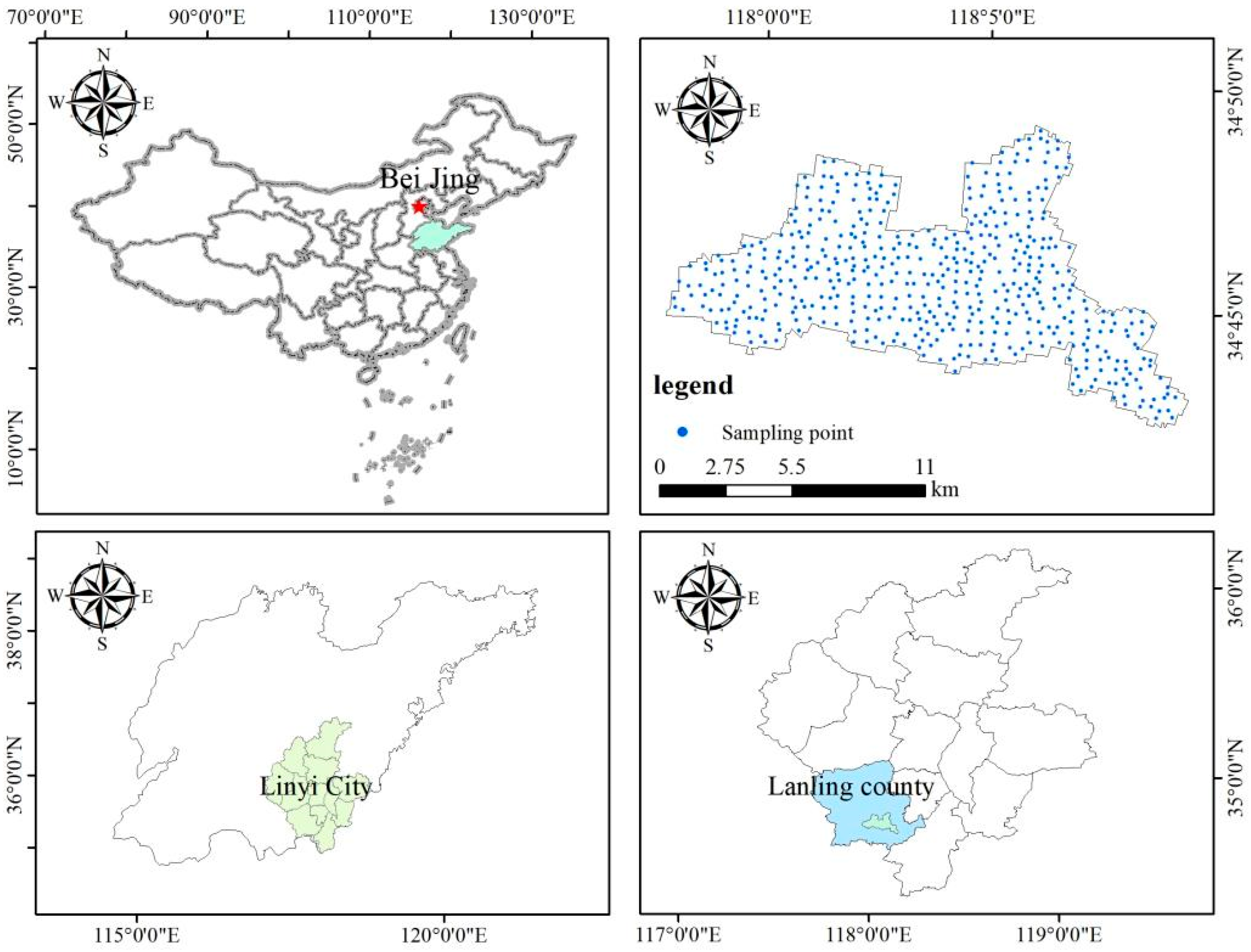
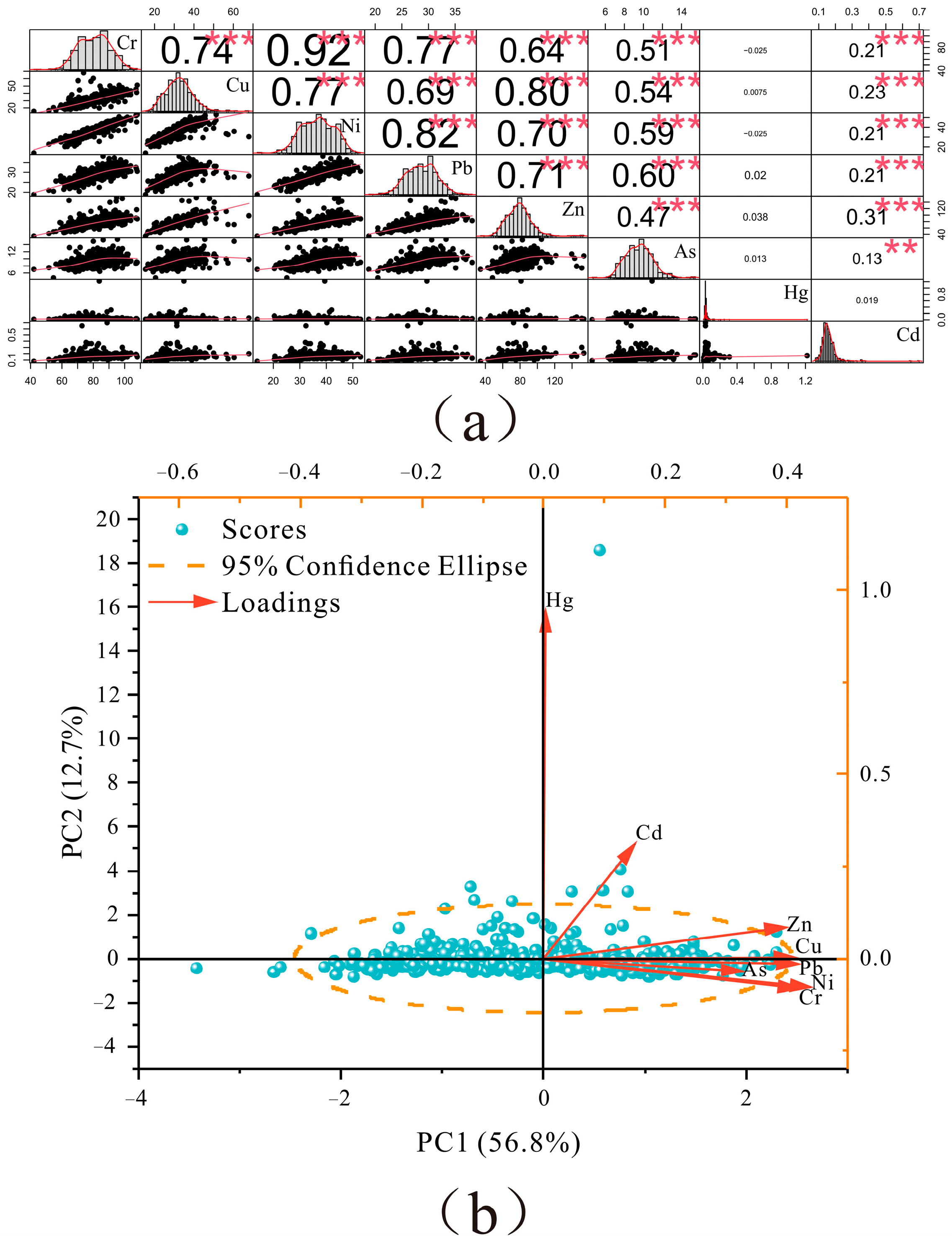
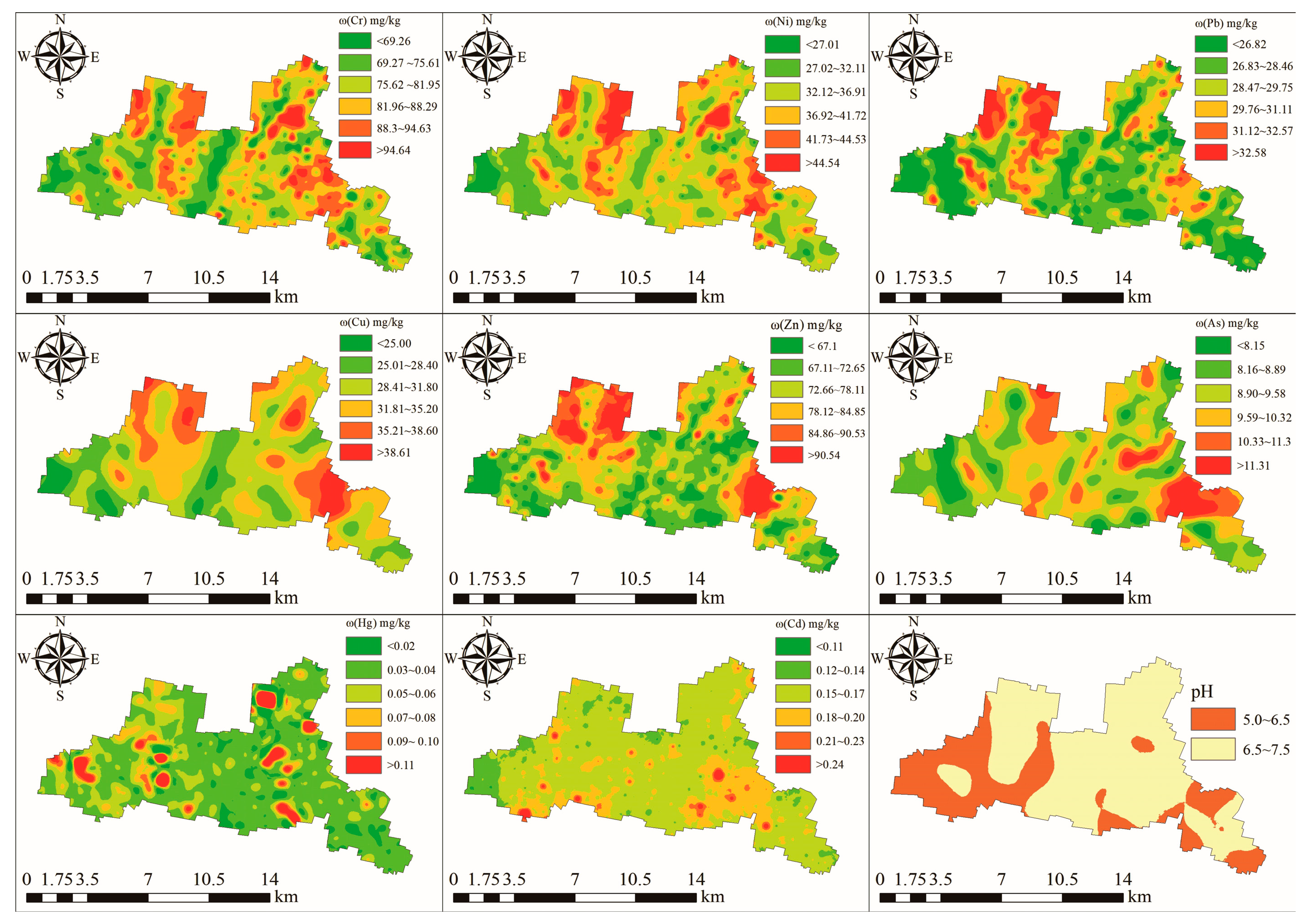
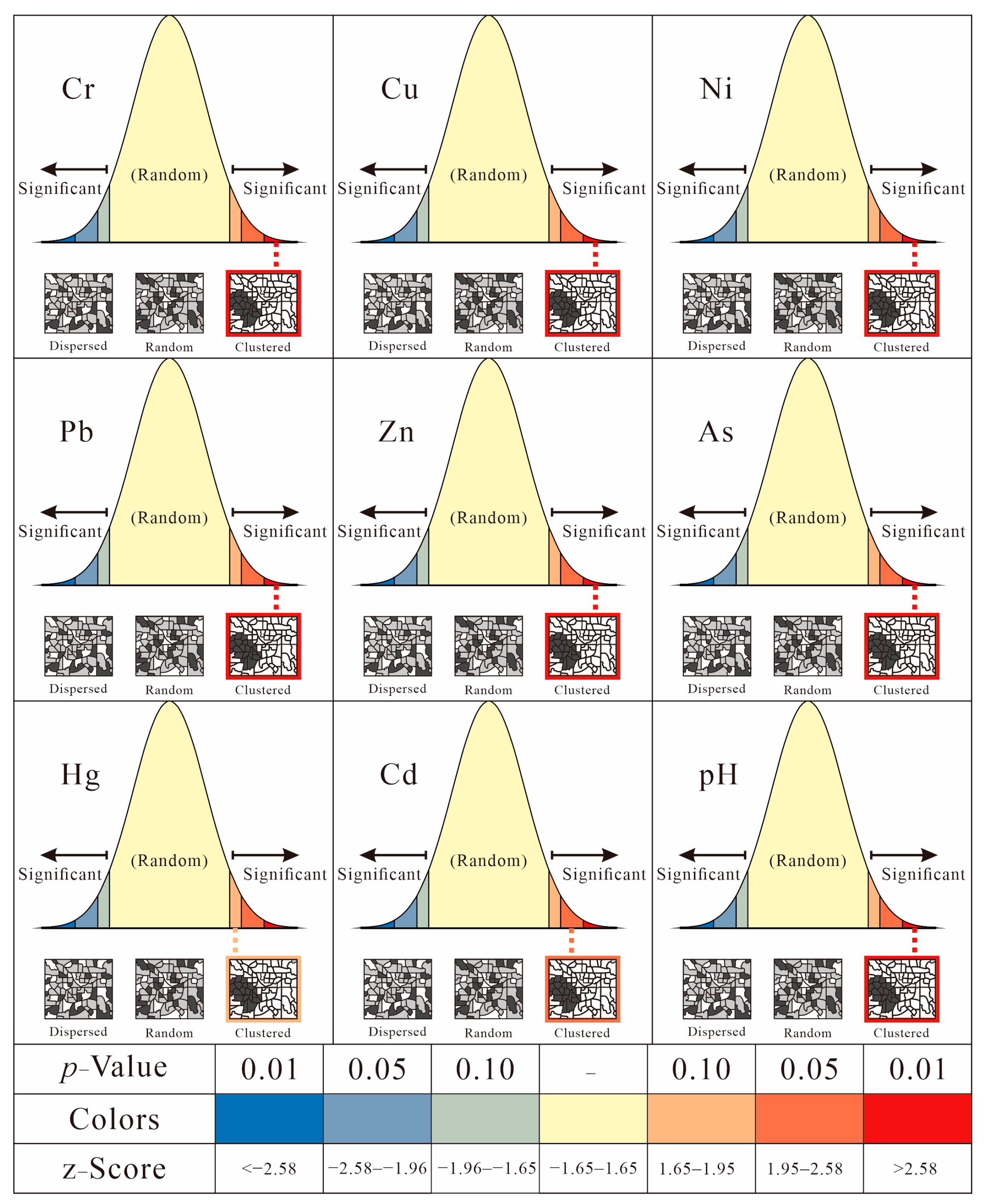
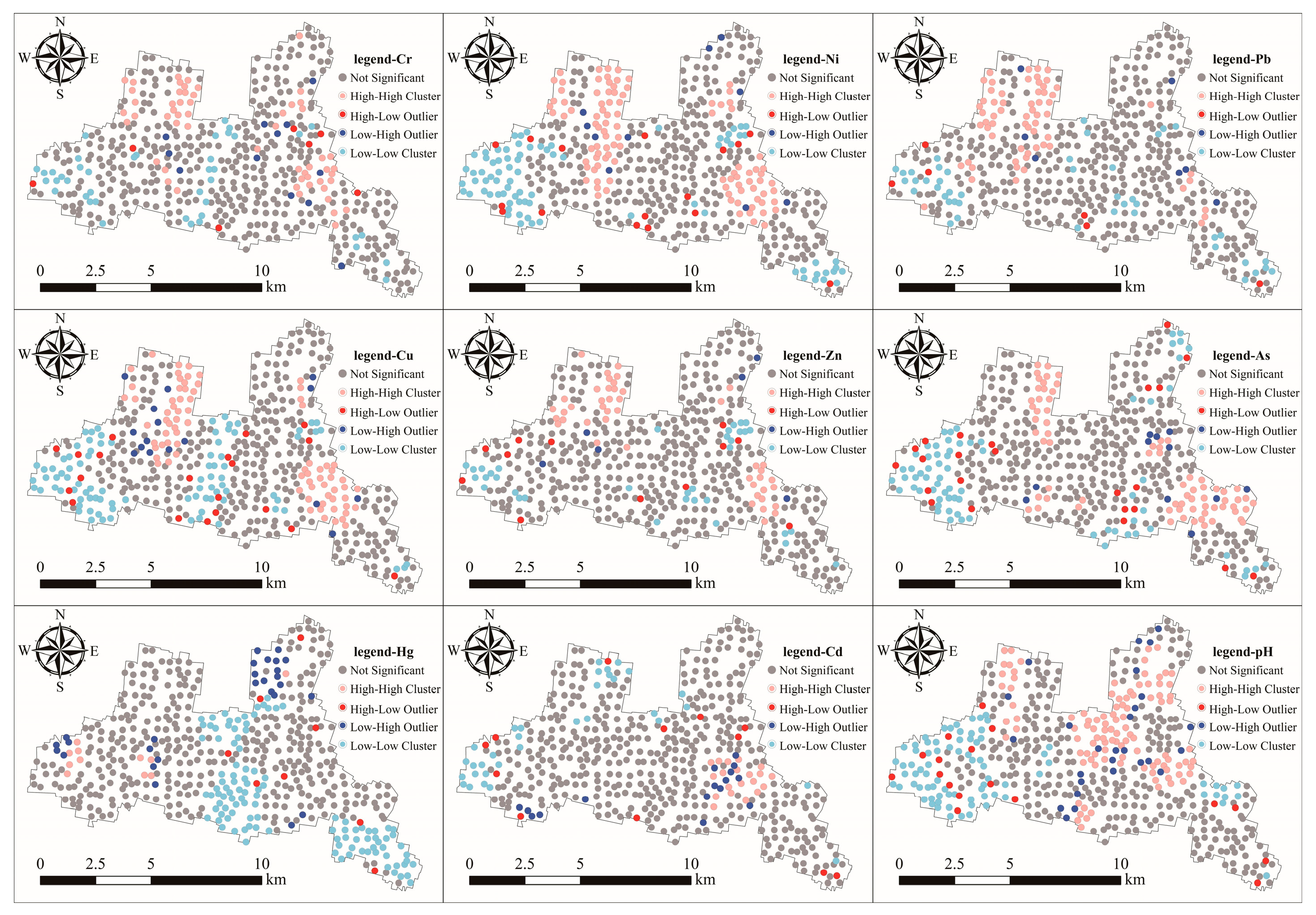

| Single-Metal Ecological Risk Index () | Composite Ecological Risk Index (RI) | Potential Ecological Risk Grading | Single-Metal Ecological Risk Index () | Composite Ecological Risk Index (RI) | Potential Ecological Risk Grading |
|---|---|---|---|---|---|
| < 40 | RI < 150 | Slight ecological hazardous pollution | 160 ≤ < 320 | 600 ≤ RI < 1200 | Very high ecological hazard pollution |
| 40 ≤ < 80 | 150 ≤ RI < 300 | Moderate ecological hazardous pollution | ≥ 320 | RI ≥ 1200 | Very high ecological hazardous pollution |
| 80 ≤ < 160 | 300 ≤ RI < 600 | High ecological hazardous pollution |
| Data | Cr | Cu | Ni | Pb | Zn | As | Hg | Cd | pH |
|---|---|---|---|---|---|---|---|---|---|
| Mean | 80.90 | 31.57 | 36.58 | 28.72 | 76.67 | 9.51 | 0.04 | 0.16 | 6.63 |
| Standard deviation | 10.39 | 6.99 | 6.53 | 3.06 | 15.17 | 1.44 | 0.06 | 0.05 | 0.67 |
| Min | 42.10 | 15.40 | 13.90 | 18.80 | 34.30 | 4.61 | 0.01 | 0.08 | 4.53 |
| Median | 81.25 | 31.30 | 36.80 | 28.70 | 76.25 | 9.52 | 0.03 | 0.15 | 6.66 |
| Max | 108.00 | 67.90 | 52.90 | 38.20 | 153.60 | 15.47 | 1.22 | 0.70 | 7.93 |
| Skewness | −0.09 | 0.70 | −0.11 | −0.01 | 1.01 | 0.43 | 16.14 | 5.34 | −0.41 |
| Kurtosis | −0.30 | 1.81 | −0.50 | −0.12 | 3.53 | 0.91 | 312.95 | 48.67 | −0.27 |
| Coefficient of variation % | 12.85 | 22.15 | 17.84 | 10.64 | 19.79 | 15.13 | 143.89 | 30.54 | 10.06 |
| National soil background value # (A layer) (1) | 61 | 22.6 | 26.9 | 26 | 74.2 | 11.2 | 0.065 | 0.097 | 6.7 |
| Jianghugongmi production area (2) | 68.21 | 23.13 | 25.52 | 27.15 | 62.44 | 7.16 | 0.04 | 0.13 | / |
| Linyi City background value (3) | 61.10 | 23.70 | 27.30 | 26.1 | 64.50 | 6.50 | 0.028 | 0.125 | 6.43 |
| Risk screening value (4) | 150 | 50 | 70 | 90 | 200 | 30 | 0.5 | 0.3 | pH ≤ 6.5 |
| 200 | 100 | 100 | 120 | 250 | 25 | 0.6 | 0.3 | 6.5 < pH < 7.5 | |
| 250 | 100 | 190 | 170 | 300 | 20 | 1.0 | 0.6 | pH ≥ 7.5 |
| Extracted Eigenvectors | Eigenvalues of Correlation Matrix | ||||||||||
|---|---|---|---|---|---|---|---|---|---|---|---|
| Factor | Cr | Cu | Ni | Pb | Zn | As | Hg | Cd | Eigenvalue | Percentageof Variance | Cumulative Variance |
| PC1 | 0.420 | 0.413 | 0.439 | 0.418 | 0.397 | 0.326 | 0.003 | 0.150 | 4.540 | 56.75% | 56.75% |
| PC2 | −0.081 | 0.003 | −0.077 | −0.014 | 0.086 | −0.342 | 0.940 | 0.308 | 1.013 | 12.67% | 69.42% |
| Heavy Metal | Expected Index | Variance | z-Score | p-Value | Global Moran′s Index |
|---|---|---|---|---|---|
| Cr | −0.001957 | 0.000240 | 14.085576 | 0.000000 | 0.216458 |
| Ni | −0.001957 | 0.000241 | 18.316794 | 0.000000 | 0.282123 |
| Pb | −0.001957 | 0.000240 | 18.028097 | 0.000000 | 0.277543 |
| Cu | −0.001957 | 0.000239 | 12.239769 | 0.000000 | 0.187446 |
| Zn | −0.001957 | 0.000239 | 13.114604 | 0.000000 | 0.200643 |
| As | −0.001957 | 0.000240 | 16.448676 | 0.000000 | 0.252800 |
| Cd | −0.001957 | 0.000218 | 2.079041 | 0.037614 | 0.028709 |
| Hg | −0.001957 | 0.000094 | 1.684103 | 0.092162 | 0.014380 |
| Heavy Metal | Mean Value of Igeo | Percentage of Samples by Grade | |||||||||||||
|---|---|---|---|---|---|---|---|---|---|---|---|---|---|---|---|
| Igeo ≤ 0 | Percentage | 0 < Igeo ≤ 1 | Percentage | 1 < Igeo ≤ 2 | Percentage | 2 < Igeo ≤ 3 | Percentage | 3 < Igeo ≤ 4 | Percentage | 4 < Igeo ≤ 5 | Percentage | Igeo > 5 | Percentage | ||
| Cr | −0.19 | 435 | 84.96% | 77 | 15.04% | / | / | / | / | / | / | / | / | / | / |
| Cu | −0.21 | 382 | 74.61% | 130 | 25.39% | / | / | / | / | / | / | / | / | / | / |
| Ni | −0.19 | 386 | 75.39% | 144 | 28.13% | / | / | / | / | / | / | / | / | / | / |
| Pb | −0.46 | 512 | 100.00% | / | / | / | / | / | / | / | / | / | / | / | / |
| Zn | −0.36 | 475 | 92.77% | 37 | 7.23% | / | / | / | / | / | / | / | / | / | / |
| As | −0.05 | 297 | 58.01% | 215 | 41.99% | / | / | / | / | / | / | / | / | / | / |
| Hg | −0.28 | 425 | 83.01% | 69 | 13.48% | 11 | 2.15% | 6 | / | / | / | 1 | 0.20% | / | / |
| Cd | 0.26 | 424 | 82.81% | 85 | 16.60% | 3 | 0.59% | / | / | / | / | ||||
| Type of Hazard Index | Heavy Metal | Mean Value of PERI | Percentage of Samples by Grade | |||||||||
|---|---|---|---|---|---|---|---|---|---|---|---|---|
| Slight Ecological Hazardous Pollution | Percentage | Moderate Ecological Hazardous Pollution | Percentage | High Ecological Hazardous Pollution | Percentage | Very High Ecological Hazard Pollution | Percentage | Very High Ecological Hazardous Pollution | Percentage | |||
| Cr | 2.65 | 512 | 100% | / | / | / | / | / | / | / | / | |
| Cu | 6.66 | 512 | 100% | / | / | / | / | / | / | / | / | |
| Ni | 6.70 | 512 | 100% | / | / | / | / | / | / | / | / | |
| Pb | 5.50 | 512 | 100% | / | / | / | / | / | / | / | / | |
| Zn | 1.19 | 512 | 100% | / | / | / | / | / | / | / | / | |
| As | 14.62 | 512 | 100% | / | / | / | / | / | / | / | / | |
| Hg | 58.65 | 82 | 16.02% | 380 | 74.22% | 36 | 7.03% | 10 | 1.95% | 4 | 0.78% | |
| Cd | 38.63 | 333 | 65.04% | 173 | 33.79% | 5 | 0.98% | 1 | 0.20% | / | / | |
| RI | / | 134.60 | 439 | 85.74% | 66 | 12.89% | 6 | 1.17% | 1 | 0.20% | / | / |
Disclaimer/Publisher’s Note: The statements, opinions and data contained in all publications are solely those of the individual author(s) and contributor(s) and not of MDPI and/or the editor(s). MDPI and/or the editor(s) disclaim responsibility for any injury to people or property resulting from any ideas, methods, instructions or products referred to in the content. |
© 2025 by the authors. Licensee MDPI, Basel, Switzerland. This article is an open access article distributed under the terms and conditions of the Creative Commons Attribution (CC BY) license (https://creativecommons.org/licenses/by/4.0/).
Share and Cite
Zhou, Z.; Shi, Z.; Yu, L.; Fan, H.; Wan, F. Soil Quality and Heavy Metal Source Analyses for Characteristic Agricultural Products in Luzuo Town, China. Agriculture 2025, 15, 1360. https://doi.org/10.3390/agriculture15131360
Zhou Z, Shi Z, Yu L, Fan H, Wan F. Soil Quality and Heavy Metal Source Analyses for Characteristic Agricultural Products in Luzuo Town, China. Agriculture. 2025; 15(13):1360. https://doi.org/10.3390/agriculture15131360
Chicago/Turabian StyleZhou, Zhaoyu, Zeming Shi, Linsong Yu, Haiyin Fan, and Fang Wan. 2025. "Soil Quality and Heavy Metal Source Analyses for Characteristic Agricultural Products in Luzuo Town, China" Agriculture 15, no. 13: 1360. https://doi.org/10.3390/agriculture15131360
APA StyleZhou, Z., Shi, Z., Yu, L., Fan, H., & Wan, F. (2025). Soil Quality and Heavy Metal Source Analyses for Characteristic Agricultural Products in Luzuo Town, China. Agriculture, 15(13), 1360. https://doi.org/10.3390/agriculture15131360







